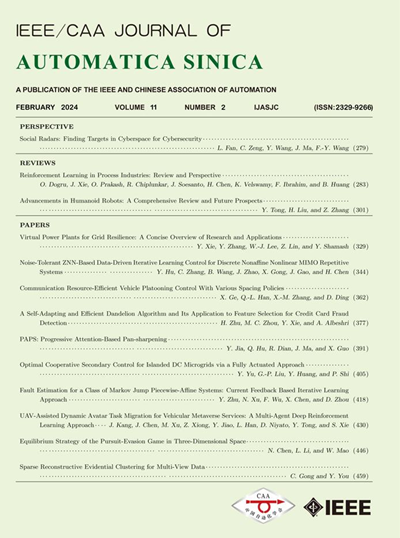嵌入式多智能体系统:综述
IF 19.2
1区 计算机科学
Q1 AUTOMATION & CONTROL SYSTEMS
引用次数: 0
摘要
多智能体系统(MASs)利用其在复杂环境中的协调和适应能力,在广泛的任务中取得了重大成就。此外,增强它们的智能功能对于解决日益具有挑战性的任务至关重要。这一目标与人工智能(AI)社区的范式转变产生了共鸣,从“互联网人工智能”到“具体化人工智能”,而具有具体化人工智能的群体被称为具体化多智能体系统(EMASs)。EMAS具有通过与环境的交互获得通用能力的潜力,使其能够有效地处理各种任务,从而为寻求人工通用智能做出重大贡献。尽管对这一领域的兴趣日益浓厚,但缺乏对EMAS的全面审查。本文从控制的角度对EMASs进行了分析和综合,将每个具身主体定义为一个具有决策“大脑”和环境交互“身体”的实体。系统设计分为开环、闭环和双环三类,并讨论了EMAS的实现。总结了EMASs的应用现状和面临的挑战,并提出了未来该领域的研究方向。本文章由计算机程序翻译,如有差异,请以英文原文为准。
Embodied Multi-Agent Systems: A Review
Multi-agent systems (MASs) have demonstrated significant achievements in a wide range of tasks, leveraging their capacity for coordination and adaptation within complex environments. Moreover, the enhancement of their intelligent functionalities is crucial for tackling increasingly challenging tasks. This goal resonates with a paradigm shift within the artificial intelligence (AI) community, from “internet AI” to “embodied AI”, and the MASs with embodied AI are referred to as embodied multi-agent systems (EMASs). An EMAS has the potential to acquire generalized competencies through interactions with environments, enabling it to effectively address a variety of tasks and thereby make a substantial contribution to the quest for artificial general intelligence. Despite the burgeoning interest in this domain, a comprehensive review of EMAS has been lacking. This paper offers analysis and synthesis for EMASs from a control perspective, conceptualizing each embodied agent as an entity equipped with a “brain” for decision and a “body” for environmental interaction. System designs are classified into open-loop, closed-loop, and double-loop categories, and EMAS implementations are discussed. Additionally, the current applications and challenges faced by EMASs are summarized and potential avenues for future research in this field are provided.
求助全文
通过发布文献求助,成功后即可免费获取论文全文。
去求助
来源期刊

Ieee-Caa Journal of Automatica Sinica
Engineering-Control and Systems Engineering
CiteScore
23.50
自引率
11.00%
发文量
880
期刊介绍:
The IEEE/CAA Journal of Automatica Sinica is a reputable journal that publishes high-quality papers in English on original theoretical/experimental research and development in the field of automation. The journal covers a wide range of topics including automatic control, artificial intelligence and intelligent control, systems theory and engineering, pattern recognition and intelligent systems, automation engineering and applications, information processing and information systems, network-based automation, robotics, sensing and measurement, and navigation, guidance, and control.
Additionally, the journal is abstracted/indexed in several prominent databases including SCIE (Science Citation Index Expanded), EI (Engineering Index), Inspec, Scopus, SCImago, DBLP, CNKI (China National Knowledge Infrastructure), CSCD (Chinese Science Citation Database), and IEEE Xplore.
 求助内容:
求助内容: 应助结果提醒方式:
应助结果提醒方式:


